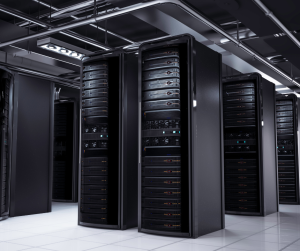The datacenters are colossal structures are the unsung heroes of the cyber domain, silently orchestrating the flow of information that powers our modern lives. Imagine a labyrinth of servers humming in unison, a symphony of data dancing through fiber optic veins, and an army of cooling systems tirelessly battling the fiery breath of technological prowess. The realm of datacenters is a realm of paradoxes – simultaneously ethereal and tangible, invisible yet omnipresent. As we embark on this expedition to explore the enigmatic world hidden behind the screens, prepare to be astounded by the sheer scale, complexity, and ingenuity that converge within these digital fortresses. So, fasten your seatbelts, for we are about to unveil the mesmerizing secrets tucked away in the core of the internet – the datacenter.
The Birth of Datacenters: Tracing Back to the Origins
The birth of datacenters can be traced back to the early days of computing when the need for centralized storage and processing became apparent. In the 1940s, large mainframe computers were housed in specially designed rooms with controlled environments to ensure their optimal functioning. These rooms, known as computer rooms, laid the foundation for what would later evolve into modern datacenters.
As technology advanced and computing power increased, the demand for more efficient and reliable data storage and processing solutions grew exponentially. This led to the development of purpose-built facilities dedicated solely to housing computer systems and supporting infrastructure. These facilities were designed to provide a controlled environment with features such as temperature regulation, power backup systems, and robust security measures.
Over time, datacenters evolved from small-scale server rooms to massive complexes spanning thousands of square feet. Today, they are at the forefront of technological innovation, housing an intricate network of servers that power everything from social media platforms to cloud computing services.
Anatomy of a Datacenter: Unveiling the Structural Marvels
Datacenters are architectural marvels meticulously designed to accommodate a vast array of equipment while ensuring optimal performance and efficiency. Let’s take a closer look at some key components that make up these structural wonders:
1. Servers: Servers are at the heart of any datacenter. These powerful machines handle data processing tasks and store vast amounts of information. They come in various forms such as rack-mounted servers or blade servers, each offering different advantages in terms of space utilization and scalability.
2. Networking Infrastructure: Datacenters rely on a robust networking infrastructure to facilitate seamless communication between servers and external networks. This includes routers, switches, firewalls, and other networking equipment that ensure data flows smoothly and securely.
3. Cooling Systems: The sheer density of servers in a datacenter generates an immense amount of heat. To prevent overheating and maintain optimal operating conditions, sophisticated cooling systems are deployed. These systems utilize techniques such as raised floors, precision air conditioning, and hot/cold aisle containment to efficiently manage temperature and humidity levels.
4. Power Supply: Datacenters require a constant and reliable power supply to keep the servers running uninterrupted. They employ redundant power sources, backup generators, and uninterruptible power supply (UPS) systems to ensure continuous operation even during power outages.
Powering the Digital Realm: Understanding the Energy Dynamics
Datacenters are notorious for their high energy consumption due to the massive computational requirements of modern applications. Let’s delve into some key aspects of energy dynamics within datacenters:
1. Energy Efficiency: With growing concerns about environmental sustainability, datacenters have been striving to improve their energy efficiency. This includes adopting energy-efficient hardware, optimizing cooling systems, and implementing advanced power management techniques.
2. Renewable Energy: Many datacenters are now exploring renewable energy sources such as solar or wind power to reduce their carbon footprint. By harnessing clean energy alternatives, they aim to minimize their impact on the environment while meeting the ever-increasing demand for computing resources.
3. Power Usage Effectiveness (PUE): PUE is a metric used to measure the efficiency of a datacenter’s energy usage. It compares the total amount of power consumed by the facility with the amount used solely for IT equipment. Lower PUE values indicate higher energy efficiency.
Security Measures in Datacenters: Safeguarding the Virtual Assets
Datacenters house a treasure trove of sensitive information, making security a top priority. Here are some key security measures implemented in datacenters:
1. Physical Security: Datacenters employ stringent physical security measures to prevent unauthorized access. This includes biometric authentication systems, surveillance cameras, access control systems, and 24/7 on-site security personnel.
2. Network Security: Datacenters implement robust network security protocols to protect against cyber threats. This includes firewalls, intrusion detection systems, encryption technologies, and regular vulnerability assessments.
3. Redundancy and Disaster Recovery: To ensure data integrity and availability, datacenters have redundant systems in place. This includes backup power supplies, redundant network connections, and disaster recovery plans to mitigate the impact of unforeseen events.
Conclusion: Reflecting on the Enigmatic World of Datacenters
The world of datacenters is a fascinating blend of technology, infrastructure, and innovation. These behemoths silently power the digital realm we rely on every day. From their humble beginnings as computer rooms to the sprawling complexes they are today, datacenters have revolutionized the way we store, process, and access information.
As we conclude our journey into the heart of the internet – the datacenter – we can’t help but marvel at the immense scale and complexity that underpins our interconnected world. The future holds even greater possibilities as advancements in technology continue to push the boundaries of what datacenters can achieve.
So next time you browse your favorite website or stream your favorite show online, take a moment to appreciate the hidden marvels working tirelessly behind the scenes – the datacenters that keep our digital lives running smoothly.
TurnKey Hosting offers diverse web hosting services, including cPanel, cloud, dedicated servers, and VPS, all backed by cutting-edge datacenter technology. We provide secure, scalable, and customizable hosting solutions for any online need.

